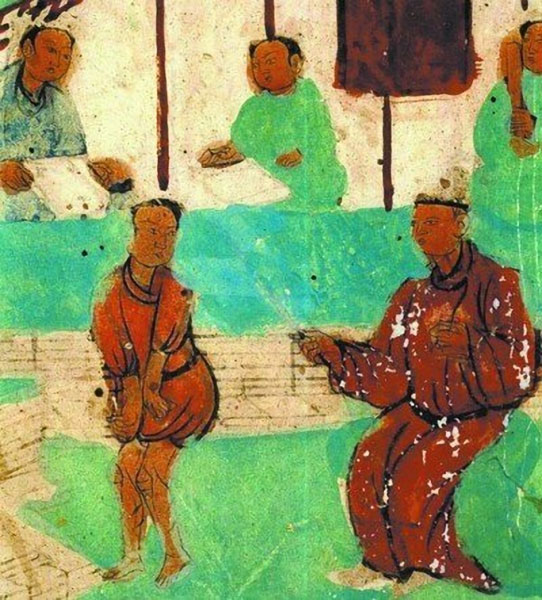
 |
|
A mural in the Mogao Grottoes of Dunhuang features a monk seemingly mimicking the signature pose of Marilyn Monroe. Provided to China Daily |
A mural featuring a monk seemingly mimicking the signature pose of Marilyn Monroe in The Seven Year Itch has managed to amuse Chinese netizens and even stirred up a new appetite for parodying the ancient paintings in the Mogao Grottoes of Dunhuang. But the developments have upset scholars, who are unhappy with the public's superficial take on Buddhist art.
Preserved in cave 468 of the world's largest Buddhist grottoes, in Gansu province, the mural in question didn't attract any attention until Chen Shiyu, a cultural magazine editor, photographed it and uploaded the picture onto douban.com. The caption read: "Afraid of being scolded by his teacher, the monk turns as bashful as Monroe."
Thousands of netizens have forwarded the picture since Chen posted it, adding an album title, "the Unexplainable Dunhuang", along with a photo of Marilyn Monroe's famous pose, to highlight the similarities.
"People used to think that Dunhuang was all about glamorous Buddha statues and delicate frescoes, but if you look at other parts of Dunhuang, there's lots of fun," Chen said.
On March 31, another post featuring the Dunhuang murals was uploaded to tianya.com, an online forum, and again was forwarded widely. The fresco, featuring a man going to the toilet, reveals what netizens call "the vulgar side" of Dunhuang.
Vulgar or divine?
The art of the Dunhuang grottoes is trending widely on the Internet in China, but scholars and Buddhists alike have mixed feelings. Although Dunhuang, a UNESCO World Heritage site, is one of China's most popular tourist destinations, few Chinese people are familiar with the archeological and artistic significance of its ancient paintings, they say. In fact, the Mogao Grottoes were never widely discussed on the Internet before the so-called "Monroe parody" was discovered.
For Zhao Shengliang, a senior researcher at Dunhuang Academy, however, the "Monroe parody" has completely missed the point.
At first sight, one can see both the monk and Monroe leaning forward with hands on bended knees. But the context and facial expression tell the difference, he noted.
During the filming of The Seven Year Itch, Marilyn Monroe was captured laughing as her skirt is blown up by a blast from a subway vent. In the cave of Dunhuang, the mural in question was created by a Tang Dynasty (618-907) painter as part of a mural to illustrate one of the 12 vows made by the Bhaisajyaguru, the Medicine Buddha, according to Zhao.
To depict the seriousness of observing precepts, the painter drew a scene where the master was about to physically punish a student who had misbehaved. This student was about to receive blows of a cane and is leaning forward but also looks upset and scared, Zhao explained.
"This is actually the earliest, and possibly the only, mural that shows a scene from the ancient temple schools, so it is very valuable," he said. "In the Tang Dynasty, the entire country believed in Buddhism. Temple schools played a great role in the education system at that time."
Aware of some people's perplexity over why a man urinating is depicted in the sacred mural, Zhao said that in Buddhist art, every word or sign has a profound meaning and shouldn't be taken at face value.
The seemingly vulgar painting is part of the mural of the Northern Zhou Dynasty (557-581) in cave 290 of Mogao Grottoes. It illustrates the auspicious signs that appeared with the birth of Gautama Siddartha, who became Buddha Sakyamuni, he said.
"When Gautama Siddartha was born, oxen and sheep bred, flowers bloomed, and all bad smells turned fragrant," Zhao explained.
"How does one depict foul odors? The painter came up with the idea of drawing a man urinating. This is the artist's way of using an image to illustrate the smell. And it is possibly the earliest image of ancient Chinese toilets."